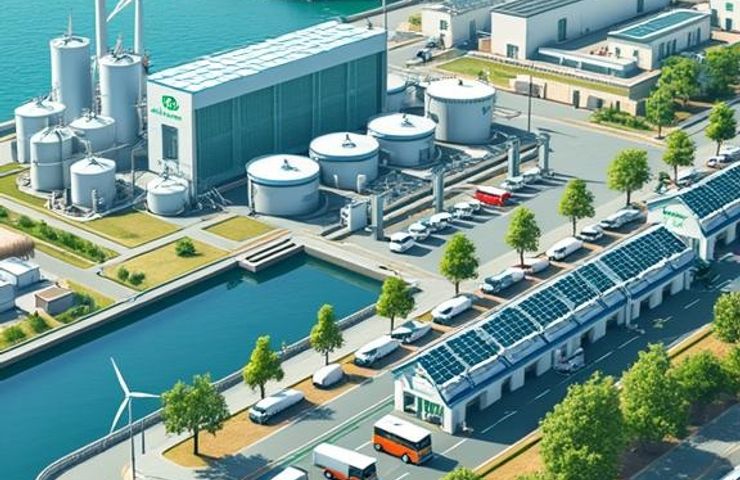
Qair Secures €55M for Hyd’Occ in Occitanie, France
October 14, 2025Project Announcement and Core Goals
Big news: Qair, France’s independent renewable energy developer, just locked in a €55 million financing package to launch Hyd’Occ—destined to be France’s biggest green hydrogen ecosystem—down in Port-La Nouvelle, Occitanie. Aligned with the EU’s push to slash emissions and champion decarbonized transport, the first phase will roll out a 20 MW electrolyser plant and string together five hydrogen refuelling stations. It’s a seamless chain covering everything from hydrogen production to the pump. When up and running, we’re talking roughly 2,700 tonnes of renewable hydrogen per year to fuel trucks, buses, and industrial users across local and pan-European routes. And just wait for phase two—that’ll bump capacity to 40 MW (about 5,400 tonnes annually), making an even bigger dent in clean mobility.
Funding and Partnerships
So, who’s backing this? Crédit Agricole jumped in with the construction loan, Bpifrance pitched in under its clean mobility mandate, and the European Investment Bank added a long-term loan—proof of the EU’s commitment to sustainable transport corridors. The Occitanie Region also threw its weight behind the project with an economic boost to spark innovation, lower carbon emissions, and generate clean-tech jobs. By mixing public and private capital, they’re spreading risk and giving hydrogen production real market muscle.
How the Technology Works
Here’s the lowdown: renewable electricity from windmills and solar arrays powers PEM electrolysers, which split water into hydrogen and oxygen. Pair that with green electricity, and you’ve got carbon-free hydrogen—no coal or gas needed. These modules can ramp up when the breeze picks up or clouds clear, then dial back during calm spells, helping to balance the grid. Once the hydrogen’s made, it’s compressed to 700 bar and stashed in tough tanks on-site. Bonus: you capture oxygen for industrial uses or let it vent safely. Trucks, buses, or industrial machines pull up to one of our five hydrogen refuelling stations, clip on a nozzle, and fill up in minutes—just like a diesel stop, but with zero tailpipe emissions. It’s a neat, clean cycle from electrons to fuel.
Solving Real-World Problems on the Road
Heavy trucks make up a tiny slice of vehicles but account for about 25% of EU road transport emissions. Battery-electric rigs often struggle with heavy batteries and limited range on long hauls. Enter green hydrogen: up to 500 km of range and refueling in under 20 minutes. Hyd’Occ already has offtake agreements for over 1,500 tonnes a year, thanks to partners like Plug Power for cross-border runs and regional operator Hydromer. Even local bus services can tap into this network, offering passengers a smooth, zero-emission ride. That’s decarbonized transport in action—keeping fleets moving without a drop of diesel.
Made in Occitanie, Made for France’s Future
‘Made in Occitanie, made for France’s future’ isn’t just a tagline. With almost 6 million residents and a history in agriculture and renewables, Occitanie is stepping up as a hub for hydrogen innovation. By tapping into regional wind and solar assets—and partnering with research powerhouses like INRAE and Cerema—we’re crafting a homegrown zero-carbon hydrogen production supply chain. This jives perfectly with the Corridor H₂ initiative, linking stations from Spain’s Basque Country through southern France into Germany and beyond. Plus, the region’s infrastructure grants are beefing up roads and power networks around Port-La Nouvelle. It’s where public strategy meets private ambition to fuel real green growth.
Environmental and Economic Benefits
In phase one, Hyd’Occ will churn out around 2,700 tonnes of renewable hydrogen each year—cutting roughly 27,000 tonnes of CO₂ versus diesel, which is like taking 12,000 cars off the road. Phase two’s bump up to 40 MW could double that to 5,400 tonnes, supercharging our Fit for 55 climate goals. On the wallet side, fleets stand to see lower total cost of ownership as hydrogen prices drop with scale, backed by solid offtake contracts. And jobs? Construction alone will spark hundreds of roles—from engineers and contractors to safety officers. Once we’re live, a core crew of technicians, operators, and logistics pros will keep things humming 24/7.
Local Economies and Supply Chains
Hyd’Occ’s ripple effects will be felt far beyond the plant gates. We’re talking local supply chains springing up: steel fabricators building tanks and pipelines; specialist firms crafting electrolysers, compressors, and control systems. You might even see hydrogen tech manufacturers setting up R&D or production hubs in Occitanie, tapping into the region’s skilled workforce. It could spark a cluster effect like France’s solar PV boom. Maintenance contracts, spare-parts supply, and training programs will also give local SMEs a boost. And with more hospitals, factories, and farms exploring hydrogen for backup power and heating, this project’s impact could stretch well beyond transport.
The Road Ahead
Hyd’Occ is on track to deliver its first green hydrogen by late 2025—mark your calendars! That milestone will kick off demo fleets and real-world operations in Occitanie. After that, Qair plans to fine-tune performance and lock in fresh offtake deals, aiming to scale the electrolyser to 50 MW by 2030. Meanwhile, Qair’s global reach continues with projects in Iceland (Katanes/Blær) and Brazil (Pecém Industrial Port), building out a worldwide green hydrogen footprint. If Hyd’Occ hits its stride, similar ecosystems could soon pop up across Europe—from Portugal’s Atlantic coast to Poland’s industrial heartland. We’re riding a paradigm shift in clean energy, and zero-emission heavy transport might just become the new normal.



 With over 15 years of reporting hydrogen news, we are your premier source for the latest updates and insights in hydrogen and renewable energy.
With over 15 years of reporting hydrogen news, we are your premier source for the latest updates and insights in hydrogen and renewable energy.